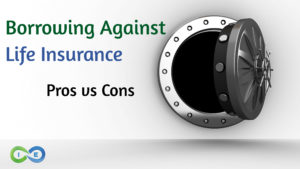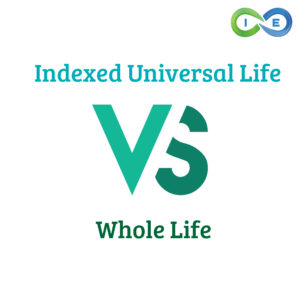There are many reasons why life insurance can be an essential component of a financial or retirement plan. Some people purchase it for the death benefit it provides, and others rely on the tax deferred cash value build-up to supplement their savings.
Not all life insurance policies are exactly the same, though. So, it is important to understand the differences between them – particularly the more common options like term, whole life, and universal life insurance – before you make a long-term commitment to purchasing one.
Term versus Permanent Life Insurance
While there are many different variations of life insurance policies, there are two primary categories of coverage. These are term and permanent. Although both of these life insurance options can provide a death benefit if the policy is in force when the insured passes away, there are some significant differences between the two.
Term Life Insurance
Term life insurance provides death benefit only coverage, with no cash value or investment build-up. These policies typically remain in force for a stated period of time (“term”), provided that the premium is paid.
A term policy is often referred to as the most basic form of life insurance coverage. Because of that, term can oftentimes be much less expensive than a comparable permanent life insurance policy, with all other factors being equal. This is particularly true if the insured is young and in good health at the time they apply for the policy.
As its name implies, term life insurance only remains in force for a set period of time – or term – such as 10 years, 20 years, or 30 years. Many insurance carriers also offer 1-year renewable term life coverage alternatives.
Because term life insurance essentially has an “expiration date,” these plans will oftentimes have to be reapplied for at the end of the time period. In some cases, a term insurance policy may be converted over to a permanent policy so that the insured can continue to have protection for the remainder of his or her lifetime (provided that the premium is paid).
If a term life insurance policy expires, the insured may have to renew the coverage, based on their then-current age and health condition. Because of that, the premium going forward is likely to increase – and in some cases, they may even be considered uninsurable.
Pros and Cons of Term Life Insurance
| Advantages of Term Life Insurance | Drawbacks of Term Life Insurance |
|---|---|
| Low premium (at least initially) | Coverage is only in-force for a set period of time |
| Beneficiary(ies) receive the death benefit proceeds income tax free | No cash value or investment build-up |
| A good solution for "temporary" coverage needs | Must requalify at the end of the term at then-current premium rates (which are usually higher due to the insured's older age and possible adverse health conditions) |
| May be convertible to permanent life insurance | Not a good solution for ongoing coverage needs or business succession planning |
Permanent Life Insurance
A permanent life insurance policy provides death benefit protection, as well as a cash value or investment component. The funds that are in the cash value grow tax deferred. This means that no tax is due on the gain unless or until the money is withdrawn.
There are several different types of permanent life insurance policies. These include whole life insurance, universal life insurance, variable life insurance, indexed universal life insurance, and variable universal life insurance. Permanent coverage will usually remain in force, as long as the premium is paid or if the policy is paid up.
The two most popular forms of permanent life insurance are:
- Whole life insurance
- Universal life insurance
Whole Life Insurance
Whole life insurance is a type of permanent life insurance coverage. With these policies, there is a death benefit and a cash value component. Although the premium on a whole life insurance policy may initially be higher than that of a term policy with the same death benefit, there is no expiration date on the coverage.
In addition, the amount of premium is locked in throughout the lifetime of the whole life insurance policy. Therefore, as the insured gets older – and even if he or she contracts an adverse health condition – the whole life insurance will remain in force for the same premium cost.
The funds that are in the cash value component of a whole life insurance policy will typically rise over time, based on an interest rate that is set by the insurance company. While the interest rate is usually somewhat low, the principal is protected in any type of stock market or economic environment. Therefore, the growth can continue to compound over time, without any losses to make up for.
Some people use whole life insurance as a way to add to their tax-advantaged savings, because there is no annual maximum contribution like on an IRA (Individual Retirement Account) or employer-sponsored retirement account.
Dividend paying whole life insurance, also known as participating life insurance, pays annual dividends that can be used to grow the cash value, pay down a loan, or withdrawn.
Whole life insurance policy holders can withdraw money from the cash value. The portion of each withdrawal that is considered gain will be taxable, though. There could also be surrender charges during the early years of the policy.
It may also be possible to borrow against the cash value of a whole life insurance policy. In this case, the funds may be accessed tax-free, as well as penalty-free. When a policy holder obtains a loan, the policy’s cash account will continue to grow and compound as if the amount of borrowed funds was still there. Because of that, many retirees use whole life insurance policy loans to supplement their income on a tax-free basis.
While a whole life insurance policy loan will accrue interest, it doesn’t necessarily have to be repaid by the borrower. Rather, when the insured passes away, funds from the death benefit proceeds can be used for the loan payoff, and the beneficiary can collect the remainder.
Whole Life Insurance Pros and Cons
| Advantages of Whole Life Insurance | Disadvantages of Whole Life Insurance |
|---|---|
| Offers tax-advantaged cash value buildup | Higher premium for a comparable term life insurance policy |
| Death benefit proceeds are locked in | Return on the cash value is low |
| Premium amount is set for life | May incur surrender charges on withdrawals during the surrender charge period |
| May withdraw funds from the cash value | |
| May take tax-free policy loans |
Universal Life Insurance
Universal life insurance is a form of permanent life insurance protection that offers a death benefit and a cash value component. Often referred to as flexible premium adjustable life, this type of insurance provides more flexibility than whole life insurance, along with more control (within certain guidelines) over the timing of premium payments, as well as where your premium dollars go to work (i.e., to the cash value or the death benefit coverage).
A universal life insurance policy is considered to be “interest rate sensitive,” meaning that the cash value in these plans is used for purchasing short-term interest-bearing financial vehicles. Because of that, the funds that are in the cash component of the policy can oftentimes increase more than those in a whole life insurance policy.
As with other types of permanent life insurance, the money in the cash / investment portion of a universal life policy grows on a tax-deferred basis. This means that no tax is due on the gain unless or until the money is withdrawn.
There are several different versions of universal life insurance available in the marketplace. These include the following:
Interest-Sensitive Universal Life Insurance
Interest sensitive universal life is another name for a traditional universal life insurance policy.
Variable Universal Life Insurance
Variable universal life insurance is similar to regular universal life insurance in the way it is structured. However, the policy holder can invest the cash value component into different types of investments like mutual funds.
Because of its investment nature, there is some risk involved with these types of universal life insurance policies. Likewise, there is no guaranteed minimum cash value offered with a variable universal life insurance policy.
Indexed Universal Life Insurance
The return on the cash value of an indexed universal life policy is based on the performance of an underlying market index, such as the S&P 500. If the underlying index performs well in a given time period, a positive return is credited to the cash value, oftentimes up to a set cap, or maximum.
But, if the underlying index performs poorly, there are no losses incurred. Rather, the cash value for that time period is credited with a minimum “floor” rate. Indexed universal life insurance policies have become popular over the past several years as a way to earn a market-linked return, but without the risk of loss in a downward moving stock market.
Pros and Cons of Universal Life Insurance
| Advantages of Universal Life Insurance | Disadvantages of Universal Life Insurance |
|---|---|
| Flexible premiums | More expensive than term life insurance (but usually less expensive than whole life insurance) |
| Tax-free death benefit for the beneficiary(ies) | Policy could lapse if cash value goes to $0 |
| Tax-deferred growth of cash value | Uncertain returns (but no losses) |
| Minimum guaranteed return, with the opportunity to do better, based on market performance | May incur surrender fees if you cancel the policy or access too much of the cash value |
| May be further customized with riders | Policy could mature while you still need the coverage |
| Longer-term death benefit coverage as compared to many term life insurance policies | Interest rate risk could occur (whereby the policy holder may have to pay a greater than planned premium in order to keep the policy in force) |
Where Certain Life Insurance Types May Fit
Everyone’s needs are different. But overall, there are some areas where term life insurance could provide a viable solution, such as:
- For “temporary” needs like a home mortgage payoff and/or making sure that funds will be available for the college education of a child or grandchild
- Offering an affordable alternative for those who have increasing insurance needs, but who may not have the large budget that may be necessary for purchasing permanent life insurance protection
In addition, a term life policy can also be used as a supplement to permanent life insurance in certain situations.
Likewise, there are also several areas where a permanent life insurance policy could be a better fit. These could include:
- Tax-advantaged cash value build up to supplement other savings (especially for those who have already “maxed out” their annual contributions to an IRA and/or employer-sponsored retirement plans)
- A strategy for locking in coverage and a set premium amount for the long-term
- The desire for additional “living benefits” where death benefit proceeds may be accessed penalty-free while the insured is still alive
- A method for paying estate taxes for higher net worth individuals and couples
- A way to ensure tax-efficient wealth transfer
- A strategy for “insuring one’s insurability” (as long as the premium is paid)
Items to Consider When Purchasing Life Insurance
There are some important items to consider before you commit to purchasing any type of life insurance policy. These should include the following factors:
- Coverage / Death Benefit Needs
- Applicant’s age and health condition
- Other potential risk factors (such as the insured’s lifestyle, smoking status, hobbies, job duties, etc.)
- Premium cost
- Other life insurance coverage already in-force
- Financial strength and stability of the insurance carrier
A primary consideration when buying life insurance is what you actually want the coverage to do for you. For instance, if you want your family to remain in your current home if the unexpected occurs, then a 30-year term life policy could be your best option, as this could provide needed capital for survivors to pay off the mortgage.
Likewise, if you are young and in good health, but you also have budgetary constraints, a term life insurance plan could provide your loved ones with the financial protection that they need – and if the policy is convertible, you could switch it over to a permanent form of coverage in the future.
Alternatively, if you are looking for lifetime coverage to use for estate planning or business succession needs – or if you want to ensure that your surviving spouse or partner can continue to receive retirement income if they lose access to your pension or Social Security benefits – a permanent life insurance policy could be right for you.
An applicant’s age and health condition can play a key factor in how much life insurance will cost, as well as whether or not they will even qualify for a policy. For instance, if you have previous heart issues, it may be more difficult to qualify for coverage.
In addition, because life insurance companies base their premiums in large part on an insured’s life expectancy, the older an applicant is, the more likely it is that they will pay more for a policy.
Life insurance companies want to know how much risk they are taking on if they accept an applicant for a policy. Therefore, they will typically review a wide array of information before they approve someone.
This includes the applicant’s age and gender, as well as prior and current health conditions. Likewise, information regarding the applicant’s family health history may also be required. In some instances, a review of the applicant’s health history from his or her doctor is needed to complete the underwriting process.
Some of the other key factors that a life insurance underwriter will consider can include:
- Prescription medications that the applicant is taking
- Whether or not the applicant is a smoker (which can include cigarettes, cigars, pipes, chewing tobacco, and the use of marijuana)
- Prior surgeries the applicant has had – and the success or failure of these procedures
Depending on the amount of coverage being applied for, it may be necessary for a life insurance applicant to undergo a medical exam. This examination typically consists of meeting with a paramedical professional who will take vital signs, such as blood pressure and heart rate. They may also require a blood and urine sample. These will be analyzed in order to determine whether or not the individual has any underlying health conditions.
While some life insurance policies are “fully underwritten,” there are others that may not require underwriting. For instance, a guaranteed issue policy is a life insurance plan that does not require the applicant to go through the underwriting process. (These policies will also typically cost more in premium, too, because the insurance company is taking on a higher risk).
Certainly, another key factor to consider before you purchase a life insurance policy is the premium cost. The amount of the premium is determined through a wide variety of criteria, such as:
- Age
- Gender
- Type of coverage
- Amount of coverage
- Health condition
- Prescription medications
- Family health history
- Lifestyle
- Occupation
- Hobbies (including dangerous activities like rock climbing or scuba diving)
- Insurance company
In addition, it is also important to review the offering insurance company to determine whether or not it is financially stable and has a good reputation for paying out its claims. You can easily do this by reviewing the ratings that the insurer has earned by agencies such as A.M. Best, Standard & Poor’s, Moody’s, and/or Fitch.
Before you purchase a life insurance policy, it is also recommended that you first discuss your needs, as well as your possible coverage options, with a life insurance specialist. That way, you will be better able to determine the right type and amount of protection that your survivors may require. Doing so can also give you a better idea of how much a term or permanent life insurance policy will cost, and what you need to do in order to qualify.
Do You Have the Right Life Insurance Coverage in Place?
Depending on your short- and long-term financial goals, it is possible that life insurance could provide you with the funds and the flexibility that you’re looking for. But because there are so many different types of coverage, it is essential to work with a professional who is well-versed in how the various alternatives work – and who can determine whether or not they will work for you.
If you would like more information, contact the life insurance experts at Insurance & Estates. You can reach us toll-free by calling (877) 787-7558, or you can send us an email at info@insuranceandestates.com. We look forward to helping you accomplish your retirement and financial protection objectives.





